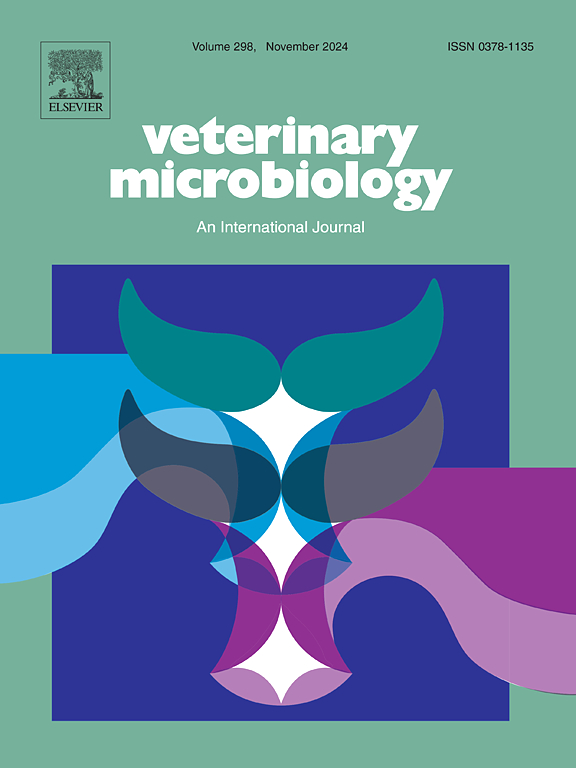Gross pathology and epidemiological features of mule deerpox virus infections in farmed white-tailed deer (Odocoileus virginianus) in Florida
IF 2.4
2区 农林科学
Q3 MICROBIOLOGY
引用次数: 0
Abstract
Mule deerpox virus (DPV) is a member of the Poxviridae family that affects various deer species, causing crustaceous skin lesions and potentially lethal infections. In this study, we aimed to investigate the spatial and temporal distribution of DPV in farmed white-tailed deer (WTD; Odocoileus virginianus) in Florida, USA, from 2017 to 2023. Necropsies were performed, and specimens were collected from 776 deer. Focusing on 145 animals with DPV-like lesions, polymerase chain reaction (PCR) testing and whole genome sequencing confirmed the presence of DPV in multiple specimen types. The results indicated that 49 out of 145 deer (33.8 %, 95 % CI: 25.7 %-40.9 %) tested positive for DPV. Mule deerpox virus was identified in 20 of the 37 counties and 8 of the 10 deer management units (DMUs) where we collected specimens. All DPV infection cases occurred in summer and fall. Lesion swabs (4/4, 100 %) and lesion tissues (16/18, 89 %) exhibited the highest PCR-positivity rates among the specimens collected from DPV-infected animals, while no whole blood samples (0/13, 0 %) tested positive. Additionally, DPV nucleic acid was also detected in fecal swabs (4/9, 44 %), suggesting that DPV may be transmitted through the oral-fecal route. Fawns aged 1–3 months (37/70, 52.9 %, 95 % CI: 41.3 %-64.1 %) exhibited statistically higher positivity rates than other age groups. This is the first study investigating the spatial and temporal patterns of DPV in farmed WTD in Florida. The findings emphasize the need for enhanced disease surveillance, non-invasive testing methods, and preventive measures to mitigate the impact of DPV on the deer farming industry and wildlife conservation.
佛罗里达州养殖白尾鹿(Odocoileus virginianus)骡鹿痘病毒感染的大体病理和流行病学特征
骡鹿痘病毒(DPV)是痘病毒科的一员,影响各种鹿,引起甲壳性皮肤病变和潜在的致命感染。本研究旨在调查养殖白尾鹿(WTD;于2017年至2023年在美国佛罗里达州饲养。对776只鹿进行了尸检,并收集了标本。以145只DPV样病变动物为研究对象,聚合酶链反应(PCR)检测和全基因组测序证实了DPV在多种标本类型中的存在。结果表明,145只鹿中有49只(33.8 %,95 % CI: 25.7 %-40.9 %)呈DPV阳性。在我们采集标本的37个县中的20个县和10个鹿管理单位中的8个县发现了骡鹿痘病毒。所有DPV感染病例均发生在夏季和秋季。在感染dpv的动物标本中,病变拭子(4/ 4,100 %)和病变组织(16/ 18,89 %)的pcr阳性率最高,而全血样本(0/ 13,0 %)未检测出阳性。此外,在粪便拭子中也检测到DPV核酸(4/ 9,44 %),提示DPV可能通过口粪途径传播。1-3月龄的小鹿(37/70,52.9 %,95 % CI: 41.3 %-64.1 %)阳性率高于其他年龄组。这是首次调查佛罗里达州养殖WTD中DPV的时空格局的研究。研究结果强调需要加强疾病监测、非侵入性检测方法和预防措施,以减轻DPV对鹿养殖业和野生动物保护的影响。
本文章由计算机程序翻译,如有差异,请以英文原文为准。
求助全文
约1分钟内获得全文
求助全文
来源期刊

Veterinary microbiology
农林科学-兽医学
CiteScore
5.90
自引率
6.10%
发文量
221
审稿时长
52 days
期刊介绍:
Veterinary Microbiology is concerned with microbial (bacterial, fungal, viral) diseases of domesticated vertebrate animals (livestock, companion animals, fur-bearing animals, game, poultry, fish) that supply food, other useful products or companionship. In addition, Microbial diseases of wild animals living in captivity, or as members of the feral fauna will also be considered if the infections are of interest because of their interrelation with humans (zoonoses) and/or domestic animals. Studies of antimicrobial resistance are also included, provided that the results represent a substantial advance in knowledge. Authors are strongly encouraged to read - prior to submission - the Editorials (''Scope or cope'' and ''Scope or cope II'') published previously in the journal. The Editors reserve the right to suggest submission to another journal for those papers which they feel would be more appropriate for consideration by that journal.
Original research papers of high quality and novelty on aspects of control, host response, molecular biology, pathogenesis, prevention, and treatment of microbial diseases of animals are published. Papers dealing primarily with immunology, epidemiology, molecular biology and antiviral or microbial agents will only be considered if they demonstrate a clear impact on a disease. Papers focusing solely on diagnostic techniques (such as another PCR protocol or ELISA) will not be published - focus should be on a microorganism and not on a particular technique. Papers only reporting microbial sequences, transcriptomics data, or proteomics data will not be considered unless the results represent a substantial advance in knowledge.
Drug trial papers will be considered if they have general application or significance. Papers on the identification of microorganisms will also be considered, but detailed taxonomic studies do not fall within the scope of the journal. Case reports will not be published, unless they have general application or contain novel aspects. Papers of geographically limited interest, which repeat what had been established elsewhere will not be considered. The readership of the journal is global.
 求助内容:
求助内容: 应助结果提醒方式:
应助结果提醒方式:


